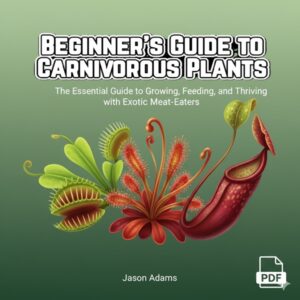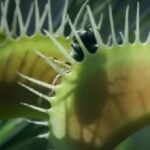As an Amazon Associate, this site earns commissions from qualifying purchases. For more details, click here.
Your Venus flytrap just finished eating then you notice one of the traps turn black. After a few days the trap dies. Should this be a cause for worry and could it affect the whole plant? in this article we will go over the facts and explain what is actually going on. If you want to know if Venus flytraps die after consuming food, read on.
Venus flytraps will not die after they eat. However, some leaves do turn black and get discarded after consuming a large meal. This is normal and new, healthy leaves will grow in their place.
Will My Venus Flytrap Die After Eating?
This question often pops up because some Venus flytrap leaves turn black after digesting prey. And usually the black leaves wither and die. But is this a sign that something is wrong with the plant?
Old Venus flytrap leaves often turn black and this is normal. Its trap can also turn black if the food is hard to digest or there is too much quantity. Black traps is normal and will not harm the plant, but it could be a problem if the black leaves start to spread.
The bottom line is your Venus flytrap might lose some leaves, but it will not hurt the plant. Even if a trap dies after digesting a bug, a new one will emerge. The nutrients the trap absorbed before dying will benefit the plant.
Ready to Grow Carnivorous Plants with Confidence?
Stop guessing and start thriving. Whether you’re raising flytraps, sundews, Nepenthes, or butterworts, this visual-first guide gives you everything you need — from lighting and watering to feeding and seasonal care.
- Beginner-proof diagrams
- Step-by-step routines
- Instant PDF download

Insects are not food for Venus flytraps, they are supplements. These nutrients are an added boost to glucose which Venus flytraps produce. About five bugs a month is enough to keep these plants happy and healthy.
So do not worry if you see a black leaf or two, that is acceptable. Traps sometimes bite off more than they can chew, but even though the trap might die the rest of the plant will be fine. In some cases the trap even survives.
However if new growth turns black and spreads, there could be an underlying problem. The wrong soil mix, not enough sunlight, lack of water or too much of it and infection are just some of the possible causes.
But it is unlikely for Venus flytraps to die specifically due to food. Of course this assumes your Venus flytrap is eating the right stuff. The only time food becomes a health threat is if the plant consumes something it is not supposed to. If your plant is not getting enough nutrients, we recommend Tetra Gold Fish Flakes. Yes it is fish food, but they are well suite for Venus flytraps too.
Why Venus Flytraps Turn Black After Eating
The plant itself will not turn black after eating, only the trap that digested the food. There are many possible reasons, but the following are the most likely. Remember that there are many types of Venus flytraps, so their reaction to food intake varies greatly.
Food is Too Large
Venus flytraps usually feast on flies, spiders, ants and other small insects. But sometimes a frog or some other large creature sets off its trap.
If the prey is too big, the trap will exhaust all of its energy trying to digest it. The trap turns black and could die. Sometimes the trap dies but is able to digest the prey. In that case, the nutrients will be absorbed by the Venus flytrap and used to produce new traps.
If your Venus flytraps keep catching large bugs, consider moving the plant indoors. They will still grow with sufficient sunlight. And you can also feed them freeze dried mealworms like Hatortempt or crickets. You can crush these into smaller bits so the trap will not have digestion problems.
If you would rather leave your Venus flytrap outdoors, there is nothing you can do to prevent it from consuming large prey. But it is nothing to worry assuming the plant is healthy. Healthy flytraps produce new traps to replace the ones that wither and die.
Too Much Food
When we eat too much food we suffer from indigestion, and something similar happens to Venus flytraps. This usually occurs when new growers feed their plant for the first time, as they tend to overdo it.
The average trap is 1 to 1.5 inches long so Venus flytraps only need a tiny amount of food. Do not cram the trap with dead bugs because it will have trouble digesting.
It does not take long for Venus flytraps to dissolve its prey, but digesting can take several days or weeks. If there is too much food, the trap might not have enough energy to consume it all.
Digesting food takes a lot out of Venus flytraps. So much so they cannot do photosynthesis. But this is a good trade off for the nutrients. While Venus flytraps can live without eating bugs, they get significant benefits from it.
But individual traps have limited amounts of energy. A blackened trap is a sign it does not have enough resources to consume food. This happens every now and then with insects, but most often when the plant is fed dead bugs or other food.
Old Age
Lastly, Venus flytrap leaves wither and blacken due to age. This is part of its life cycle and is to be expected. Each trap has a limited closing capacity and will die once it is used up.
There is nothing you can do about this, and that is fine. Just make sure the plant receives enough light, water and is properly fed. If you meet all these then black leaves and traps will not cause any serious problems.
Even a healthy Venus flytrap will lose several traps due to age. What is important is the plant itself is in good condition. As long as it is, those dead traps will be replenished.
How to Stop Venus Flytraps From Turning Black
Now that you know the reasons why Venus flytraps can turn black after eating, here are some tips to prevent it from happening. Follow these suggestions and you also reduce the possibility of the plant suddenly dying.
- Proper feeding. You only need to give food to one trap. Once the trap has finished eating and reopens, you can feed it again. Sometimes it might take a week to digest food, sometimes two. Let the trap take its time.
- Small amounts of food only. Venus flytraps do not need to eat bugs to survive. So giving it a small amount will not hurt.
- It is best to leave your Venus flytrap outdoors so it can catch live prey. Or leave it indoors by an open window. If you want to hand feed it, take care not to give too much.
- Do not overwater. Too much can cause root rot or black leaves. As long as the soil is moist that is enough. Letting Venus flytraps sit in water is acceptable.
- No beetles or cockroaches. Or any insect with a hard exoskeleton. Venus flytraps have a difficult time digesting this and can kill traps.
- No feeding during dormancy. Venus flytraps do not need to eat when dormant. Wait until the plant rises again in spring.
- Do not touch the traps. Do not check if the trap can bite you or if it hurts. This is very stressful to the trap and could shorten its lifespan.
What Happens When Venus Flytraps Eat Insects?
Venus flytraps secrete digestive juices to dissolve its prey. When the tissues have been liquefied, the plant starts absorbing it, along with the enzymes it released. Hard shells or anything inedible will left out.
The trap stays closed during the digestive process. When the food and digestive enzymes have been absorbed the trap will open again, ready to catch more.
This process can take a while and if the plant is not in good health could weaken it further. The process starts with luring the prey and trapping it. If the bug is small enough there will not be any problems. But a caterpillar, earthworm or other large insect could rip through the trap.
Losing a trap is not an issue as long as the Venus flytrap is healthy. But even a healthy plant will not have enough resources if you overfeed it. This will not kill the plant overnight but its traps will die, and if you continue will weaken the whole plant.
Conclusion
Venus flytraps are very different from a regular houseplant, so it takes some getting used to. Black leaves or traps may look alarming but usually it is not a cause for worry unless it happens repeatedly. The key is to know your Venus flytrap well.

My fascination with carnivorous plants began many, many years ago with Venus Fly Traps. Now I am more than happy to impart what I know with other enthusiasts and those who are curious about meat eating plants.



